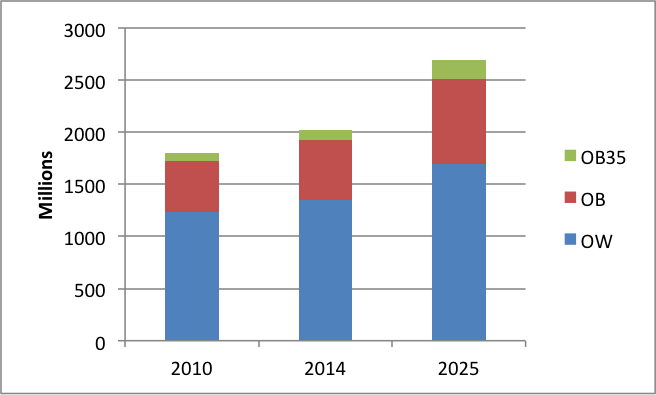 Tim Lobstein is Director of Policy at the World Obesity Federation.
Tim Lobstein is Director of Policy at the World Obesity Federation.
Today marks the very first World Obesity Day. Launched by the World Obesity Federation, its aim is to draw greater attention to the continuing global obesity crisis. Regular readers of these blogs may recall that four years ago, in 2011, the UN General Assembly held a special http://www.worldobesity.org/what-we-do/action-initiative/aiprogrammes/world-obesity-day/session (a very rare event) on the urgent need to tackle non-communicable diseases (NCDs) – and their causes.
Following the meeting, governments across the world pledged that by 2025, they would reduce by 25% premature deaths from cardiovascular diseases, cancer, diabetes and chronic respiratory diseases – and the World Health Organization set a specific target for obesity.
Given that World Cancer Research Fund International’s analysis of global research shows that obesity increases the risk of 10 cancers, as well as heart disease and diabetes, the target for obesity was remarkably modest, ie. that there should be no further increase by 2025. Many of us feared that this ‘no increase’ target would seriously hamper the ability to meet the 25% cut in the obesity-related chronic diseases that were being promised.
But as the obesity prevalence levels for 2010 were taken as the baseline for governments to meet their 2025 targets, we can now start to ask the question: how are the trends going and are governments on course to restrict obesity at the levels they were at in 2010?
Obesity levels are rising
The World Health Organization recently published estimates for the global overweight and obesity levels for 2014. Whereas in 2010 obesity prevalence stood at 11.5% of adults – equivalent to some 565 million people – by 2014 the figures had increased to 13% (670 million people). This is not a hopeful sign.
If nothing is done, and trends from 2010 to 2014 continue at the same rate, the target will certainly not be met, and indeed will spectacularly fail. The World Obesity Federation predicts that obesity will rise to 17% of all adults, or some 995 million people.
If you also include the number of people who are overweight but not obese the total comes to 2.7 billion adults with excess weight by 2025, up from 2 billion in 2014.
Trends for global overweight, obesity & severe obesity

OB35 = severe obesity; OB = obesity; OW = overweight. Source: World Obesity Federation 2015
Obesity levels in developing countries rising rapidly
These figures assume that things carry on just as they are. But everything points to an escalating problem. While the levels of obesity in many westernised economies seems to be stabilising, in developing economies obesity levels have shown a rate of increase never seen in Europe or North America. Some 18 countries from the Caribbean to the Middle East to the Pacific islands have already overtaken the USA in the obesity league tables.
Urgent government action required
Urgent action is needed, not just to meet the UN-agreed targets but for the sake of people who are already obese and those facing the real risks of becoming obese. Access to treatment services will need to be rapidly widened – by 2025 some 170 million adults worldwide may have a BMI over 35 kg/m2, which is the threshold for urgent medical treatment.
Preventing obesity means tough government action to limit the promotion of junk food, especially to children, to ensure healthier food is offered at work, in schools and other institutions, and to encourage physical activity through better urban design and transport systems. Like climate change, we know the answers to the obesity crisis.
We know that tough policies will need to be implemented, and we know that such policies are challenged by powerful commercial interests. But we have no choice if we hope to meet those 2025 targets.


